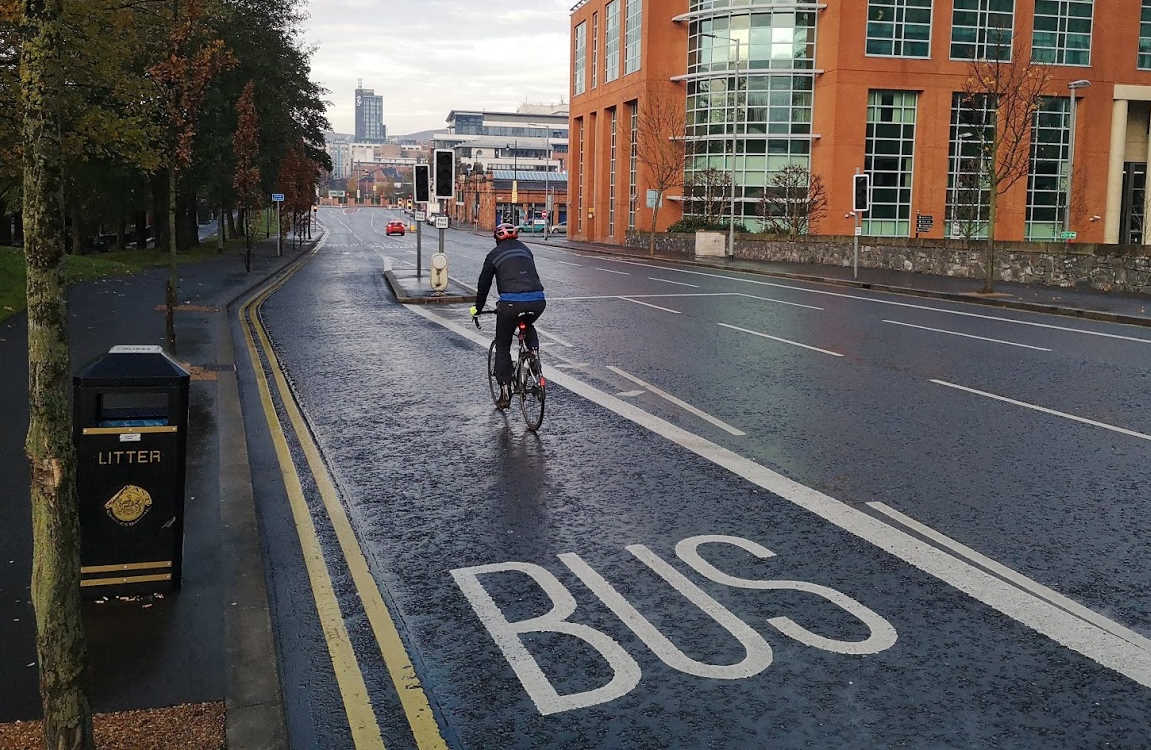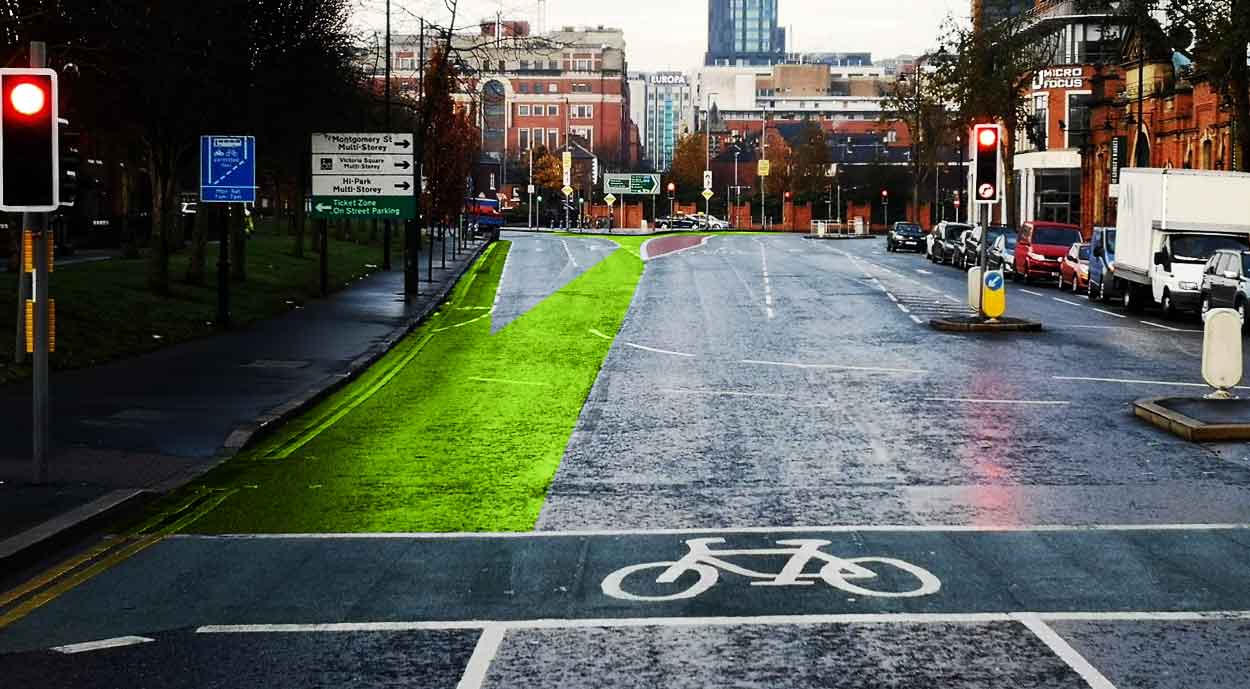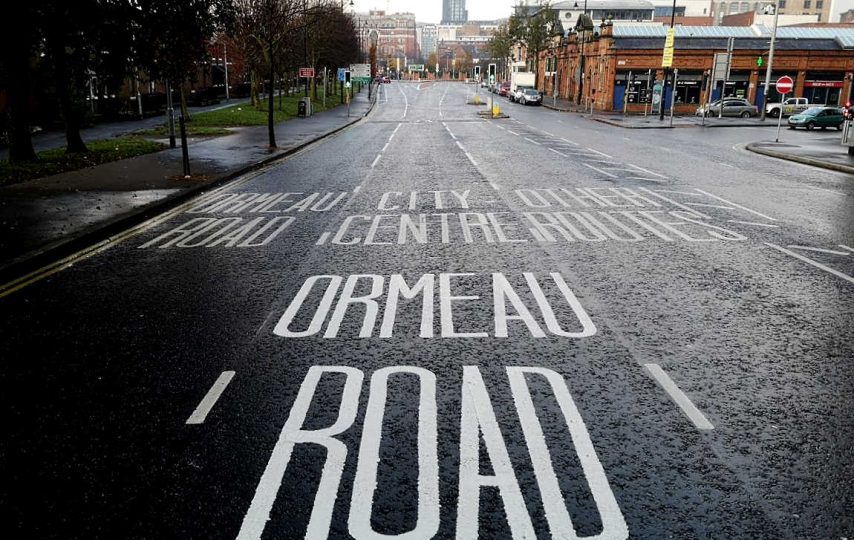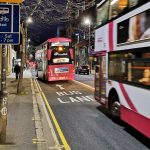A realignment of traffic flow on a key route from East Belfast to the city centre has created significant additional risk and a barrier to people travelling by bicycle.
This change was made without warning, prior notice, or consultation with cycling groups. It had already been stopped six years ago, in part due to an article published on nigreenways.com – which handily covered all of the problems which have now come to pass – but the Department for Infrastructure (DfI) ignored those warnings and has now crassly rolled out this change just in time for Road Safety Week 2019.
What’s changed and why is this a problem?
On approach to the city centre, a bus-and-bicycle gate ensures priority for those cycling into the left hand lane – handy in the teeth of a busy rush hour.

Past the bus gate the three lanes were marked as follows:
- Left – ORMEAU ROAD
- Middle – CITY CENTRE
- Right – OTHER ROUTES

Previous lane markings on East Bridge Street approaching Cromac Street
Beyond the junction with Oxford Street which merges from the right hand side, this meant the left lane headed left towards Cromac Street, and the middle and right lane headed right to the city centre and Victoria Street.
Where this helped cycling journeys was the signed priority to hold the left land AND still access the city centre. This was via the slip lane to Hamilton Street (the street where the Europa Hotel is peeking through in the image below) or use a handy cycle lane access beside the bus lane to head towards Victoria Street.

This was not ideal for less confident users, but it gave those cycling equal priority for direct access to the city core WITHOUT having to attempt a risky lane change in rush hour traffic.
The main danger has always been impatient drivers flying down the middle and right hand lanes to avoid queues, and merging across to the left before the bus lane. But it’s important to remember, this went against the signed priority marked on the road.
“Road Service have now marked out a lane divider from the Oxford St junction, meaning left hand lane traffic (and most cyclists) will now have to indicate and give way to traffic on their right to make an attempt to reach the city centre; traffic in the ‘outside’ lane which is generally faster and less patient than the left hand lane (see videos). Cyclists will have to negotiate two lanes instead of one.”
DRD’s nightmare on East Bridge Street, nigreenways.com, August 2013
And so to the innocuous looking change that fundamentally changes the junction dynamic for those cycling – by rewarding that deliberately poor lane discipline of impatient motorists.

New markings on East Bridge Street approaching Cromac Street
The inside lane now has a marked lane from the Oxford Street junction, holding you in to the side of the road, and giving those in the middle lane full priority to choose to drive left to the Ormeau Road or right to the city centre.
This cuts off the option for safely accessing the city centre from the left lane, forcing everyone on a bicycle to have to indicate right with an arm out and hope for rush hour traffic to let them cross.
“Experienced cyclists may be prepared to handle this extra hassle, but for the large group of people who’ve recently taken up cycling and those we want to encourage to swap out of the car, this is a major backward step in the feeling of safety and confidence. Bad junctions simply stop people from choosing to cycle.”
DRD’s nightmare on East Bridge Street, nigreenways.com, August 2013
There is now an additional barrier of vehicles in the way of cycling journeys to the city centre.

A constant, prioritised flow of left turning traffic from the middle lane now cuts off city centre access
Anyone pinned into cycling in that left hand lane will also face pressure of expectation from drivers to use the tight, bumpy advisory cycle lane – which ends at the bend in the picture. It’s a mess.
Does this change fit in with policy?
Talking last week to DfI Roads – the DfI section who manage this street – the change was initiated by complaints about the junction, and some of those complaints came from “cyclists”. If that was the case, then any changes must surely benefit those cycling here.
We’ve asked DfI Roads for copies of any risk assessments for cycling carried out to inform the changes, or any assessments of cycling flows across the junction – to confirm the anecdote that the majority of those cycling in rush hour will be accessing the city centre.
The irony shouldn’t be lost on anyone that just this week Strava Metro suggested East Bridge Street is on the top road corridor in Belfast for cycling, with usage peaking during weekday morning rush hours.
Heatmaps, via @StravaMetro, of transportation cycling in Belfast. https://t.co/Np3xFhm44Y @nigreenways pic.twitter.com/sDLjdZSCAW
— Carlton Reid (@carltonreid) November 20, 2019
How does an additional barrier to cycling help to support the public hire Belfast Bikes system, with a key trip generator on this corridor between nodes in the city centre and Central Station?
Draft Programme for Government measure 25 places a responsibility on DfI to “increase the percentage of all journeys which are made by cycling.” As a responsible public body, DfI should be able to show how this junction change contributes positively to this measure, if the PfG means anything.
Just last month DfI released their annual report on “Attitudes to Walking, Cycling and Public Transport in Northern Ireland.” Looking at the concerns which people have about cycling, a generous read would suggest that eight of the top ten issues have either not been addressed or actively made worse in this junction redesign.

Attitudes to Walking, Cycling and Public Transport in NI 2018/2019, DfI, October 2019
Is the wider Department for Infrastructure fit to control its own work to follow policy to make our streets better for active and sustainable travel, or does DfI Roads – the state within a state – get to decide whatever it wants to do, and without consequence when it works to undermine wider policy?
What’s the solution?
We’ve already requested an urgent meeting this week to discuss the matter. DfI Roads have promised a response via email by mid December. (In case you were in any doubt about how cycling is treated within DfI Roads.)
The solution is in three parts, in order of priority:
- an immediate reversion to the former lane markings
- then, a new junction redesign to better protect and promote cycling journeys
- ensuring mistakes like this are not repeated by inviting Sustrans to sit on DfI’s Cycling Programme Board and, as a trusted stakeholder, to be consulted on such changes to streets with high cycling usage
You can already see the moves to stall on part one.
Part two involves planning in protected space for cycling, but cannot be used to frustrate or bypass part one – the lead time is likely to be years.
The final part has been requested several times as DfI Roads continue to clatter into problems, poor design, ill-considered schemes and botched implementations.
The resistance to that suggestion has been strong, and speaks to a hardened cultural resistance to openness and collaborative working within the old Road Service – unacceptable in the Programme for Government era which promised “a system of Government that works across boundaries, organisations, groups and communities for the common good.“
What can you do to effect change?
Very simply, the Department for Infrastructure makes such alterations on the basis of public complaints. It’s our understanding that only a handful of complaints led to the above change.
To force a quick rethink you need to send an email to DfI Roads Eastern Division:
dfiroads.eastern@infrastructure-ni.gov.uk
The Department has form in dismissing boilerplate emails from “cyclists” so we’re not providing a cut-and-paste option – you should send them a short email detailing your own personal concerns and experience of the changed lane priority.
You can also contact your local elected representatives to add pressure on the Department to think and act with vulnerable users’ needs first, instead of the usual knee-jerk to make vehicles flow faster.
@nigreenways is exactly right, these changes have made this junction dangerous for cyclists. @deptinfra https://t.co/Kt6TPvEalu
— john kyle (@cllrjohnkyle) November 17, 2019




Many Thanks for this – absolutely right – wrote to DfD and my councillors.